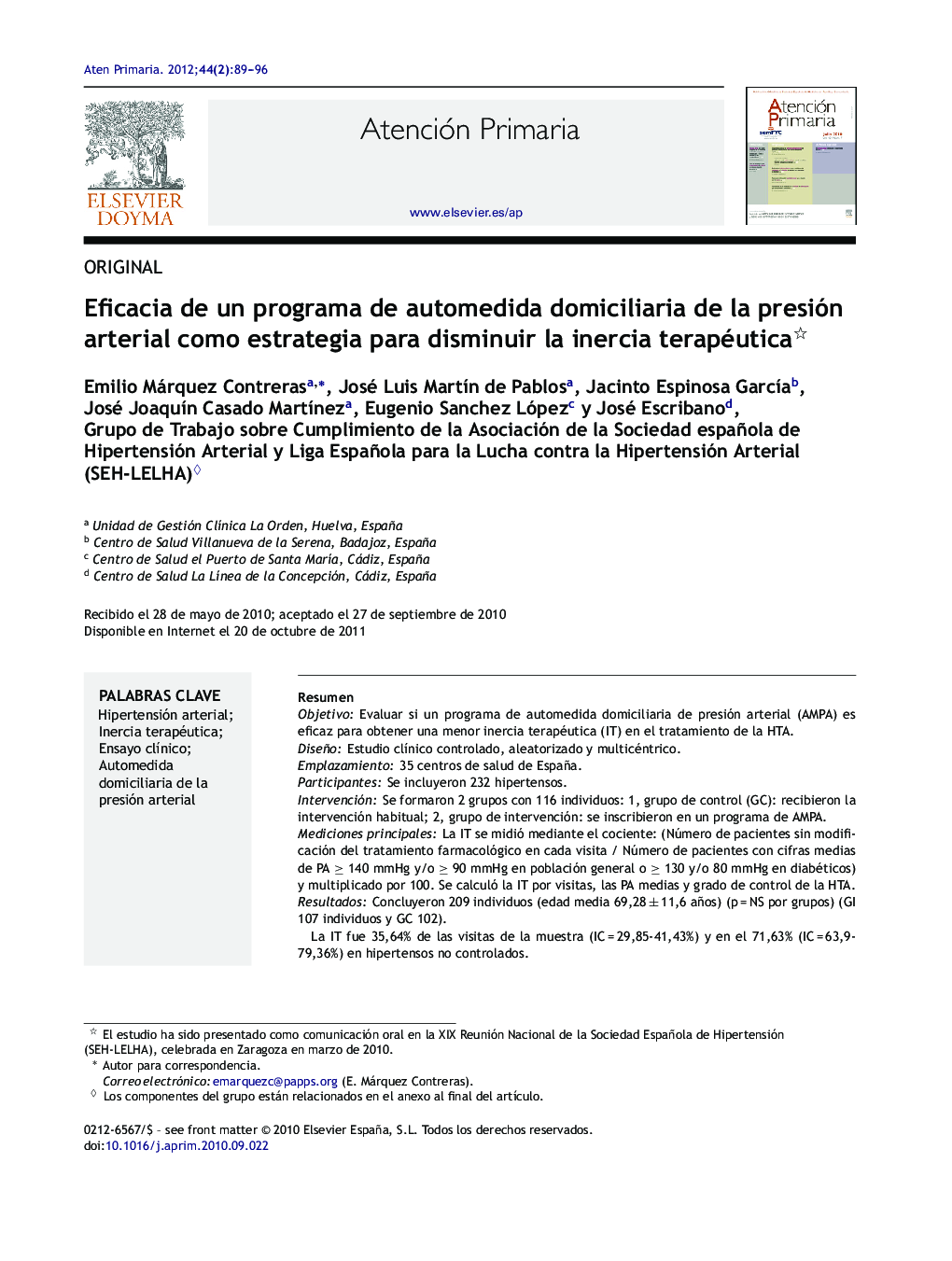| کد مقاله | کد نشریه | سال انتشار | مقاله انگلیسی | نسخه تمام متن |
|---|---|---|---|---|
| 3457805 | 1230933 | 2012 | 8 صفحه PDF | دانلود رایگان |

ResumenObjetivoEvaluar si un programa de automedida domiciliaria de presión arterial (AMPA) es eficaz para obtener una menor inercia terapéutica (IT) en el tratamiento de la HTA.DiseñoEstudio clínico controlado, aleatorizado y multicéntrico.Emplazamiento35 centros de salud de España.ParticipantesSe incluyeron 232 hipertensos.IntervenciónSe formaron 2 grupos con 116 individuos: 1, grupo de control (GC): recibieron la intervención habitual; 2, grupo de intervención: se inscribieron en un programa de AMPA.Mediciones principalesLa IT se midió mediante el cociente: (Número de pacientes sin modificación del tratamiento farmacológico en cada visita / Número de pacientes con cifras medias de PA ≥ 140 mmHg y/o ≥ 90 mmHg en población general o ≥ 130 y/o 80 mmHg en diabéticos) y multiplicado por 100. Se calculó la IT por visitas, las PA medias y grado de control de la HTA.ResultadosConcluyeron 209 individuos (edad media 69,28 ± 11,6 años) (p = NS por grupos) (GI 107 individuos y GC 102).La IT fue 35,64% de las visitas de la muestra (IC = 29,85-41,43%) y en el 71,63% (IC = 63,9-79,36%) en hipertensos no controlados.La IT fue del 22,42% (IC = 24,2-37%) en el GI y 50% (IC = 37,75-62,25) en el GC (p < 0,05) en visita 2, y del 25,23% (IC = 14,84-35,62) y 46,07% (IC = 33,85-58,29) en visita final para GI y GC respectivamente (p < 0,05).ConclusionesLa IT ha sido muy relevante. El programa de AMPA es eficaz para obtener una menor IT.
ObjectiveTo evaluate the efficacy of a program of home blood pressure monitoring (HBPM) on therapeutic Inertia (TI) in mild-to-moderate hypertension (AHT).DesignControlled, randomised clinical trial.SettingForty six clinics in 35 primary care centres. Spain.ParticipantsA total of 232 patients with uncontrolled hypertension were included.InterventionTwo groups with 116 patients were formed: 1) Control group (CG): standard health intervention; 2) Intervention group (IG): patients who were included in the HBPM program.Main measurementsTI was calculated by the ratio: Number of patients whose pharmacological treatment was not changed in each visit/Number of patients with an average BP 140mmHg and/or 90mmHg in the general population or 130 and/or 90 mmHg in diabetics. The mean BPs and the percentage of controlled patients were calculated. The mean number of people that required an intervention in order to avoid TI was calculated (NI).ResultsA total of 209 patients completed the study, with TI in 35.64% (95% CI = 29.85%-41.43%) of the sample, and in 71.63% (95% CI = 63.9-79.36%) of the uncontrolled hypertensive patients.The TI was 22.42% (95% CI = 24.2-37%) in the IG and 50% (95% CI = 37.75-62.25) in the CG (p < .05) in visit 2, and 25.23% (95% CI = 14.84-35.62) and 46.07% (95% CI = 33.85-58.29) in the final visit for IG and CG, respectively (P < .05). The NI was 4.3.ConclusionsTI was very significant among the uncontrolled hypertensive patients. The studied interventions are effective for improving TI.
Journal: Atención Primaria - Volume 44, Issue 2, February 2012, Pages 89–96